Here’s the programme schedule of our training course.
>>> Download the PDF-file here.
We were divided into differents small groups.Each group had 5 people, where everyone in the group had to present the pictures made in relation to migration.
My group was composed by:
1. Me (Imelda): I showed pictures in relations with my integration ( picture of myself in the World youth conference ion Trieste 2015) and 3 others pictures about arrival by sea of people in Italy.
2. Abdel: His pictures showed his work, supporting a Syrian family with translation, housing search, administrative procedures,etc… But also his participation within a training course in Spain to discuss youth challenges in the arabic and European countries.
3. Luisia: Her pictures showed her work within Roma people (Kids and families).
4. Marieke: Her pictures shows Family and Friends from Syrian and other.
5. Matteo: His pictures showed his work in the migration field.
6. Tania: pictures showed her work in the migration field.
7. Raluca: Her pictures showed racism in Italy. Migrant in Italy from Romania don’t manage to have friends. (Senegal migrants in Italy are the best).
8. Anita: Volunteering in migrant center in Sicily.
Here are the links to Nai Wen’s project:
We started the 9th day of the workshop with an excursion to the intercultural youth organisations Amaro Drom e.V. /Amaro Foro e.V. which are organisations that empower Roma people with different kinds of projects (e.g. youth groups, children program, community building, contact point, volunteer program).
When dealing with discriminated groups of migrants it is very important to talk about the situation of Roma people in Germany and Europe. Antiziganism it is a widespread racist attitude which has received little attention in society and has a big impact in the mobility of Roma people in Europe and in their everyday life. Therefore we think that it is important to raise awareness and therefore include it in the program. Furthermore, it helps us to gain insights on work and life-experience of participants. Unfortunately, the presentation and the way of presenting was not convincing. We would have liked to hear more about the current situation of Roma people concerning the change of law (e.g.declaring more countries of origin as save) and the consequences, such as the deportation and activist movements against. We also felt that the presenting person was not really open, in the sense of responsiveness to our questions and differing opinions. So, even though we know now about the activities of these organisations, it did not meet our expectations.
Our next stop was a refugee shelter in Pankow. It has been previously a hotel, but it was not working very well. Therefore, two brothers bought the hotel at the beginning of 2015 and decided to open it like a refugee hotel, hosting 270 people of 17 different countries, thereby taking advantage of the current situation because the social authorities pay 15 to 25 € per person per night.
Despite the commercial aspects of the accommodation, there is a big network of social workers and a volunteers that are doing a great work within the opportunities in refuge shelter and in the city district of Pankow. For the first time we got to know a project that was having a more feminist perspective and was trying to include women in activities outside their family environment. It was also impressive to notice the well working cooperation between this shelter and the city district which allow children to go to the school without long waiting time.
Open Space
It’s the last day of the training course “Dealing with Migration”. It has been an intense experience which has allowed all the participants to get together from all over Europe, to work and discover the topic of migration. It was a wonderful opportunity for all of us to be empowered and to have the chance to be more aware of different aspects of this reality. Twenty five people from seven European countries and different backgrounds shared best practices and ideas on the topic of migration. Non formal education activities and all the informal time that we shared brought us surprises and insights about other people’s cultures. In this time of globalization and of cultural homogeneity it was good to discover the differences and the richness of our cultures which represent one of the best resources for Europe and the world.
Now it’s time for us to say goodbye and to take back what we have learned and hopefully be active in our own countries.
Let’s see what some of the participants have to say about the experience!
Tanja – Trainer from Solar e.V.

The training had a good impact on me. I also learned some new aspects about the topics also from the participants of the different countries. It was also enriching on a personal level because the atmosphere was really great! We would like to continue also in the future on the topic of migration and continue networking with the organization from different countries.
Olivera – Participant from Serbia

It was really good, interesting. I looked at migration from a macro level and I saw that different countries have similar issues dealing with colonial past and their own racism, xenophobia, islamophobia and how these issues intersect. We all have the same fight and we should network and share our experiences and examples of good practices. I am glad we had some days when we had to question our position and privileges and it was very important that we understand that all people are racists.
Olivian – Participant from Romania

The workshop was really insightful and gave me certain perspectives I didn’t have in the past. The activities were great and very useful, and after this course I’m thinking of adapting some new techniques I learned here to start new workshops in my home country on the topics of migration, racism, classism, xenophobia. Also, the organizers created a true safer space, and the participants bonded on such a great level, that we felt comfortable enough to start a slow process of deconstruction. This was an unforgettable experience.
Matteo – Participant from Italy

I really liked the organization, the richness of the topics and all the points of view I had the opportunity to know. I go back home with a lot of inputs, thoughts and with a positive energy that I will implement in my activism with migrants. The atmosphere we managed to create was really helpful and was very important for the work we did together. Apart from these very positive things, during these days sometimes I had the feeling that something important was missing and now writing this comment I realize that we didn’t have the possibility to focus and go deeper in the topics because of the full schedule.
Megi – Participant from Georgia

The training course was a great European experience for me. Georgia is a developing country, so it is very important for us to learn from the examples and experiences of other countries. It was a great opportunity to see different ways of dealing with migrations, problems and challenges that our countries are faced with.
The training was well organized with lots of interesting information, exercises and activities. I am going to miss Kubiz, our wonderful group and the trainers.
Abdel – Participant from France

The training course was really a great opportunity for me to discover new cultures and nice people from different countries. It has allowed me to gain a lot of competences that will help me in my professional and personal life. Also, the program was really interesting and well organized, and it has given us the opportunity to share our experiences and to learn from each other. In a few words, it was a fabulous experience, we became a small family and I will miss all the participants , and I d like to wish them good luck and all the best !
Marie – Participant from the Netherlands

This training course has shown me how many people are willing to make a change in this world and how we can connect knowledge, experiences and our passions for making change. Connecting with people from different nationalities and backgrounds brings new perspectives in the topic of migration and it has taught me a lot about the essential need of deconstructing mainstream perceptions that feeds exclusion, racism and xenophobia. I am inspired and motivated to use the methods and the discussions we developed and to apply them in my work and in my daily life. The group became very close and it would be wonderful to meet up in the future to see where this course has brought us…

At the end of each training day, we were asked by the organizers to move to the evaluation in small groups, to enable them to have an idea about our perception of things related to the lessons of the day. We were free to talk about the things we liked or not.
The 3 main issues were:
1. What did you like?
R/ For this day, we liked the fact that many of us have a good mobility experiences.
2.What didn’t you like?Was there anything you found problematic and why?
R/ We liked all the lessons of the days.
3. What was missing? and what is your suggestion?
R/ The Only suggestion was about food, where people asked the variety of food,corresponding to different types of diets.

On Saturday the 28th of November which was the 5th day of our program, it was time for our post-colonial tour through Berlin. On this cold winter day, when the first snow of the year covered our hairs, we did not know what to expect, but we soon found out…
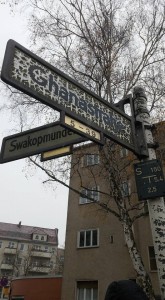
Josephine, our tour-guide, was waiting for us at the exit of the metro station in Wedding. She guided us through the colonial history of “ das Afrikanische Viertel”, German colonialism and how racism is currently still being reproduced through colonial references. We started our tour at ‘Ghanastrasse’. On first glance, this street seems just like the average suburban German street. But during the tour, we stopped at street corners several times, where we were confronted with the ‘dark side’ of these street names. The sensitivity of the topic was instantly felt when we noticed that Josephine was very conscious in her word choices. For example, when referring to ‘Mohrenstrasse’, a street name with racist connotations, she chose to use the word ‘M-Strasse’. In our perception, this was done to deconstruct the colonial/racialized concepts instead of reproducing them.

At a certain point, we stopped at a particular street corner called ‘Petersallee’. Josephine told us that in colonial times, this street was named after Carl Peters. This man was known as a highly controversial colonialist. The notorious aspects of his life were reflected through various atrocities that were attributed to him. For instance, during the German colonial era, Peters was responsible for founding the Society for German Colonisation, later renamed the German East Africa Company. The purpose of this organization was to ensure as many ‘protectorates’ for the German Reich as possible. Seizing, controlling and de-facto colonizing these lands was paired with a great deal of violence and brutality. Later, Peters also became known as ‘Hängepeters’, which referred to his bloody methods that among others involved the hanging of his enslaved concubine and her lover and burning down their villages after he found out about their affair.
 When we stopped at Swakopmunder Strasse, which is named after a city in Namibia, Josephine told us about the history of German colonialism in Namibia. What happened there was a prelude to what was to come in Nazi Germany, since the Germans established their first concentration camps in Namibia. People were used as slaves and sometimes tall Namibian men with ‘masculine’ features were taken to Germany to be displayed as trophies or status symbols. From the information provided during the tour, it became clear that the colonial past is still very much present and heavily debated in different layers of the German society. For instance, when regarding the example of the Namibian genocide, an official apology by the German government was issued as late as August 2004.
When we stopped at Swakopmunder Strasse, which is named after a city in Namibia, Josephine told us about the history of German colonialism in Namibia. What happened there was a prelude to what was to come in Nazi Germany, since the Germans established their first concentration camps in Namibia. People were used as slaves and sometimes tall Namibian men with ‘masculine’ features were taken to Germany to be displayed as trophies or status symbols. From the information provided during the tour, it became clear that the colonial past is still very much present and heavily debated in different layers of the German society. For instance, when regarding the example of the Namibian genocide, an official apology by the German government was issued as late as August 2004.
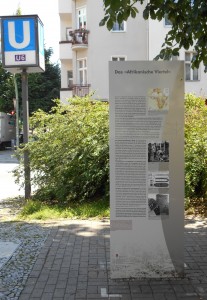
After a long discussion, the writers of the information board in the quarter could not agree on their writings. So they decided to write two different texts about the quarter, on one side of the board a text was provided by NGOs and local activists, on the other side a text was written by politicians and the local assembly. Josephine purpously started at the side which was written by the NGOs. On this side you could see the word Afrikanische Viertel in quotation marks and photo’s of the cruelty of the colonialists.  On the other side she showed us that the slaves were portraited as powerless victims. For instance, the colonialists discussed their colonies in their conferences and after colonialism everybody was living happily ever after.
On the other side she showed us that the slaves were portraited as powerless victims. For instance, the colonialists discussed their colonies in their conferences and after colonialism everybody was living happily ever after.

In October 2004, a local assemblyman proposed a motion to rename ‘Mohrenstrasse’ (Blackamoor Street) and thereby set in motion a debate about how to deal with colonial references present in public space. The proposal was heatedly debated in the media, in public meetings, university departments, postcolonial- and anti-racist activists, citizen initiatives, various NGO’s and local politicians. Unfortunately, this proposal was refused by the majority of the local assembly. However, they did decide to pass a resolution to promote the ‘critical examination’ of German colonialism. Furthermore, an information board was set up in the ‘Afrikanische Viertel’ to contextualize the street names in this part of the city. Nevertheless, the discussion of what ‘critical examination’ actually means, continues today (Engler, 2015).
For instance, the street name of ‘Petersallee’ has only been changed to a certain extent. When local activists proposed to change the name, the local assembly decided to only change the historical reference of this person. This was done by adding an additional sign to the ‘Petersallee’ that refers to Prof. Dr. Hans Peters, instead of changing the entire street name. This practice of contextualizing and (partly) renaming controversial street names, in fact perpetuates a double standard. This double standard becomes even more clear when making a comparison to the example of the German Socialpolitik. During this period, many hurtful and notorious Nazi-references were removed from public spaces. While up to now, the same has not been achieved for the colonial references that are still clearly visible to the public eye.
We ended the tour in a cosy café, where we had a discussion with Josephine about our impressions. Summing up, we are able to say that the tour showed us how colonialism and racism are still intertwined to our present daily lives. We might not notice it, but we are confronted with it every day. For example by passing by or living in streets that bear names of a dark and terrible history. The fact that we are often not aware of this, is part of the problem: racism is structurally internalised in our minds. We can only achieve equality in society by making sincere efforts to decolonize our minds.
Reference:
Engler, J. (2015) Renaming Streets, Inverting Perspectives: Acts of Postcolonial Memory Citizenship in Berlin, Focus on German Studies, 20. Humboldt University of Berlin.
On 7th day of the Training course “Dealing with migration” we had three workshops on the topics perspectives of people of color and on responsibility. They were designed to offer a different perspective for analyzing white privileges and discuss case studies related to the 21st century colonialism and its effects (inequality in wealth distribution, migration and internal displacement of people). These topics were already introduced in the previous days.
The workshop was conducted by Lawrence Nana Yaw, freelancer and facilitator in activities using the critical whiteness method. After introducing himself, he distributed to all participants a worksheet with four questions:
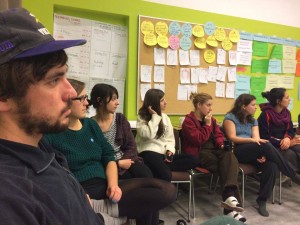
In explaining the method, the facilitator projected Jane Elliott’s appearance of Oprah’s show in 1992, in which she applies methods of critical whiteness to the participants of the show and indicated there are 4 stages that are to be identified in exploring this method: denial, shame or guilt, recognition and healing. These steps are a cycle and a continuous struggle with your own personal identity.
Critical whiteness methods are means to provoke people to discuss and confront with whiteness and white identity. Their goal is to “helping students come to a critical awareness of the history of whiteness”, “to understand the material effects of white privilege”, to understand the power of white discourse in history and education and to “help students form a positive, anti-racist white identity” (Nichols 2010, 4-5).
In our workshop, the method raise confusion and controversy among the participants, as they became antagonized on the outcomes of the workshop.
While some appreciated being confronted with questions related to their identity and the history they knew, others felt the method is aggressive and can lead to communication barriers between the participants and the facilitator.
Therefore, we recommend attention to the following aspects:
– while the method is designed to get participants out of their comfort zone to think critically of their identity, the facilitator must pay attention that participants don’t disengage from the discussion without a wish to return.
– the method should not be implemented by a facilitator which has built a deep trust line with the participants, if this line is important for his future presence and work in the community.
– the method should be evaluated at the end of the workshop, especially when it is implemented with trainers which will replicate it in their respective communities.
Our second workshop on responsibility was called the Reverse of wealth. Firstly we were divided in six groups and were assigned to watch video, analyze it and later present it to our fellow participants. We analyzed six case studies on coltan mining in D.R. Congo, free trade agreements, climate refugees, Niger delta oil industry (Shell), child labor on cocoa farms in Burkina Faso and land grabbing in Africa.
We had a task to look closely on a certain questions while providing descriptions and making conclusions. The questions were following:
1. Give a short description (key words) of the phenomena?
2. In how far the “Global North” is responsible for this situation?
3. How the phenomena/situation is connected to migration phenomena?
Taking responsibility
We should take the responsibility, not to support these exploitation and stop buying the products. The “Global North” creates inequality, poverty, hierarchical power structures, human rights violations and aggressive approach in “Global South” and thus should take responsibility for creating this kind of situations. We also agreed that there is a large hypocrisy of the governments that turn a blind eye and support companies and corporations of the “Global North” that actually enjoy great benefits of this exploitation.
We also concluded that there is lack of investments in disaster prevention and preparedness.
(You can find links to the used contents in the resources section)
Game that shows in interesting way how little we know and how we look at the world.
There were five continents and three information that participants should have guessed about population, GDP and number of refugees. Based on their guesses people stood on piece of paper with name of continent. They were faced with actual number and they were able to compare.
We used chairs to show distribution of wealth (GDP). Each person sits on its own chair and with it it is on a continent, then they leave chairs were they choose and moved to another continent if results are different according to the real numbers.
 Results – For population answers were a lot different than reality, two or three difference then in reality, for GDP similar happened but with a bit less difference and for number of refugees on every continent results were rather accurate.
Results – For population answers were a lot different than reality, two or three difference then in reality, for GDP similar happened but with a bit less difference and for number of refugees on every continent results were rather accurate.
Discussion – Method can be adopted on countries or regions for distribution and other indicators. Negotiation process was a challenge for participants but overall it was a success.
We started our day with morning circle where we shared impressions from Colonial tour in which we participated in on Saturday.
Working schedule was opened by Tanja, where she presented *Antibias approach*. You can find more about it at this pptx-file.
In the morning activities were interesting, important and good, but not very well connected. After Antibias presentation we did *Power Flower* which was simple but effective tool we used to examine our own privileges. The fact that we found it difficult to decide where to colour in some areas as it can depend on context, perspective and comparison meant that we were probably also quite privileged in those areas. The small group discussion afterwards led us to reflect even further on our privileges. It was very interesting discussion and it particularly struck us the opinions about institutional discrimination and personal discrimination.
*What opinion exists in your country related to Syrian regufees*
This was the next activity where, for some participants it was uncomfortable to represent their countries because it is not easy to give realistic image of how refugees are seen in their contries. We did talks in small groups and presented our discussions afterwards. Views on this topic were different regarding to the country we are coming from. For example, in wealthy countries such as Netherlands one of the main discourses is that Syrians came to rape our women, in France after Paris attack they are quitting the fonds for refugees, still representing them as that they came to take our money and jobs. In transit countries like Serbia, people are scared that they will bring diseases and destroy parks, make a lot of trash.
What was significant about these two exercises (Flower Power and opinion about refugees) is that we worked in small groups, so that everybody had a chance to talk and had more space to share opinions with others.
*Activists Report*
We had a presentation from the activist, who shared his experience of being a refugee and fighting for the rights of refugees in Germany, from non institutionalized perspective. It was a good opportunity to hear the voice of someone who has this experience.
He made powerful opening of the presentation, where we had 30 seconds of silence for people who are dying, people who died on their way to Europe.
He explained situation of refugees in Germany, how they are selforganized and thier self organisations and he talked about common political struggle which was quite interesting since he introduced different ways people organize to support refugees. Some ways of being in common political struggles are: indepented individuals, anti racist initiatives, churches, registered associations, political parties and para govermental organization.
He made critisism about how different initiatives works and explained that he doesn’t want to represent refugees since he sees himself as “privileged refugee” cause he can go to school, have access to public fonds etc. We had some doubts about his position that he took in this presentation, because he did talk about the life of refugees so it was difficult to seperate his personal experience and point of view from the other refugees, so for us he was representing refugees. Also, it was hard to start a discussion cause he wasn’t really willing to listen to the others and understand what they actually wanted to say. But he did give us diferent inputs and knowledge about this topic and the history facts that we didn’t know about.
And the most fun of the day was *Open space* where one part of the group went outside with Josh, to collect different items, while others stayed in green room with MAtteo doing activity about stereotypes. With Josh we tried to create relation with our identity related to the place where we are.
Activity purpouse from MAtteo is in this guide (Diversity Activities Resource Guide and the name of the activity is “Whom to leave behind”.
On the 4th day of the training we started working on a performance about our home and identity and we all agreed that it was one of the most significant and touching days at KuBiZ. It mainly happened because we got to know each other in a more personal way, we were fully involved in this adventure and we shared memories and feelings.
All of this was made possible by our lovely Chang Nai Wen who co-developed the „Berlin Bound” project and who was the facilitator of our HOME experience. „Berlin Bound” was created because the crew of artists figured out that especially in Berlin, many people share the experience of leaving their home in a search for something new and they establish themselves as being members of a foreign culture and society.
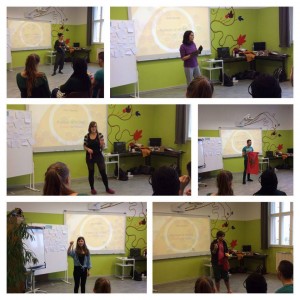
All the activities we did throughout the day were focused on our own perspective about migration and they represented our experience towards a new set of rules, adapting to new cultures and ultimately, creating a common ground.
In order to reach all of the above we’ve passed through „Go – stop – say your name – jump” warm up activity where the rules of the game were reversed and it was the first step of building something together. Afterwards, by standing in a circle, everyone introduced themselves by associating their name with a gesture and their idea of home with a feeling. Home functioned as a multitude of sensations connected to a place , a song or a person: „Home is breakfast”, „Home is Balkans”, „Home is where I can be myself”, „Home is where I have nothing to prove”, „Home is yellow flowers in the springtime”, „Home is my cat”, „Home is where I can be comfortable”, „Home is on the way”, „Home is happiness”, etc.
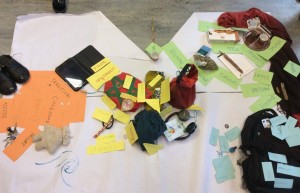
In order to share our essence and individuality we were invited during the preparation phase to bring a piece of home – something cherished or hated: the Moroccan flag, slippers, house keys, biscotti, Palo Santo wood, singing spoon, zatar, childhood toy, a card visit from a wine bar, ID, a hole in a cardigan, etc. After the presentation of the items, we found a safe place where our most valuable belongings connected with other people’s pieces. In this way small groups were connected due to sharing the same idea about home. Through the mind mapping technique we told our stories and we wrote down key words describing our common ground. This was the base of creating participatory performances by each small group. Every group had to put together a theater performance based on their own idea about home by involving the audience to step in and interact with the characters.

Even if we started by creating a scenario, in the end we finished improvising the performance and the great thing about it was that nobody knew the result of the performance, therefore we played with the unexpected itself. For example, one of the groups managed to take us back in our childhood times and succeeded to involve the audience into sharing personal stories. On the stage there were also played a spontaneous party, a train journey and a family dinner. We all reacted like a big family and supported other performances with smiles, cheers, claps, constructive feedback and intervention.

From our point of view, this specific method was very interesting and challenging because we had to use our memories, ideas, feelings and bodies in order to create a whole piece of home. The body was an important instrument of moving energies, a great tool to use when the mind is too heavy to speak.
This whole theatrical puzzle helped us connect, interact and realize that although there are a lot of differences between us, there is a common home that we bring with us wherever we go. With just a small piece of home, friends around and a safe environment you can create something valuable and meaningful.
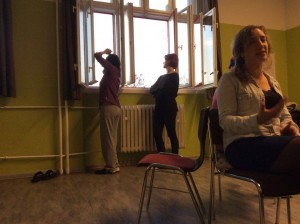
Action Research
The Second half of the day focused on The Action Research Method. As a method of research, Action Research focuses “on the conditions and effects of various forms of social action and research leading to social action” and uses “a spiral of steps, each of which is composed of a circle of planning, action and fact-finding about the result of the action”. Experience is an essential part of the action research process. After choosing the topic of focus, and developing questions, the research group must actively engage in the community or situation of question (similar to participant observation). More infomation about the Action research method can be found here and visually in this diagram below. 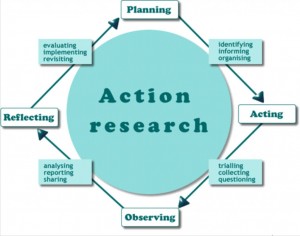
Action Research Groups
The cohort was split into 5 smaller groups. Each group was given a specific set of social organizations in Berlin, ranging from Churches,Shelters, NGO’s etc… which deal with issues of migration in different ways. Each group was given a list of different places to explore and then return to the larger group to report on their findings the next day. This excecise gave the groups an opportunity to journey together through the city of the day, gain a some practical exposure to the issues we’ve been discussing, as well as discover the easily accesible affordances of this place. Here’s an overview of places visited by the groups:
Group 1:
Gorki- Museum and Experience Play: Refugee’s Library an exhibit and interactive play which focused on the experience of being a refugee in a fictional country where a language nobody understands is spoken.
Group 2
 Borderline Europe: An Organization which observes humans rights issues on the borders of European union
Borderline Europe: An Organization which observes humans rights issues on the borders of European union
Group 3
Church Asylum: The German Ecumenical Committee on Church Asylum (Ökumenische Bundesarbeitsgemeinschaft Asyl in der Kirche) is a network of associations of German protestant, catholic and free church parishes ready to offer church asylum.
Emergency Refugee Shelter
Group 4
Kubus: An organization which actively supports youth and elderly welfare with a focus on intercultural coexistence of people of different nations and cultures through language education and vocational training
Reach Out: a counselling centre for victims of rightwing extremist, racist or anti-Semitic violence in Berlin.
Group 5
LeGeSo: LEGESO was in the past the State Department of Health and Welfare in Berlin Settled medical book stock was the central point for the German military medical records from both World Wars. Today the offices are completely working in supporting migrants, ensuring all the administrative tasks for their conditions of life, to allow them to live or to work in Germany
MOABIT HILFT: Working with refugees who are often traumatized, speak little or no German language. MOABIT HILFT gathers a group of local residents, institutions, associations and businesses from Moabit to contribute to helping these new residents.
Each group had it’s own experiences (which will be further discussed in the next days blog), but it is safe to say that this research method can be and efficient way to organize a research project, espescially in a short period of time. It is quite beneficial as a group activity considering that it can serve many purposes in a simple structure, allow research questions to be experiences in the context of the local community, as well as facilitate group socialisation and team building. Furthermore, many could imagine using this particular 1-day exercise in Action Research in as good way to introduce research methods for those learning how to do research.